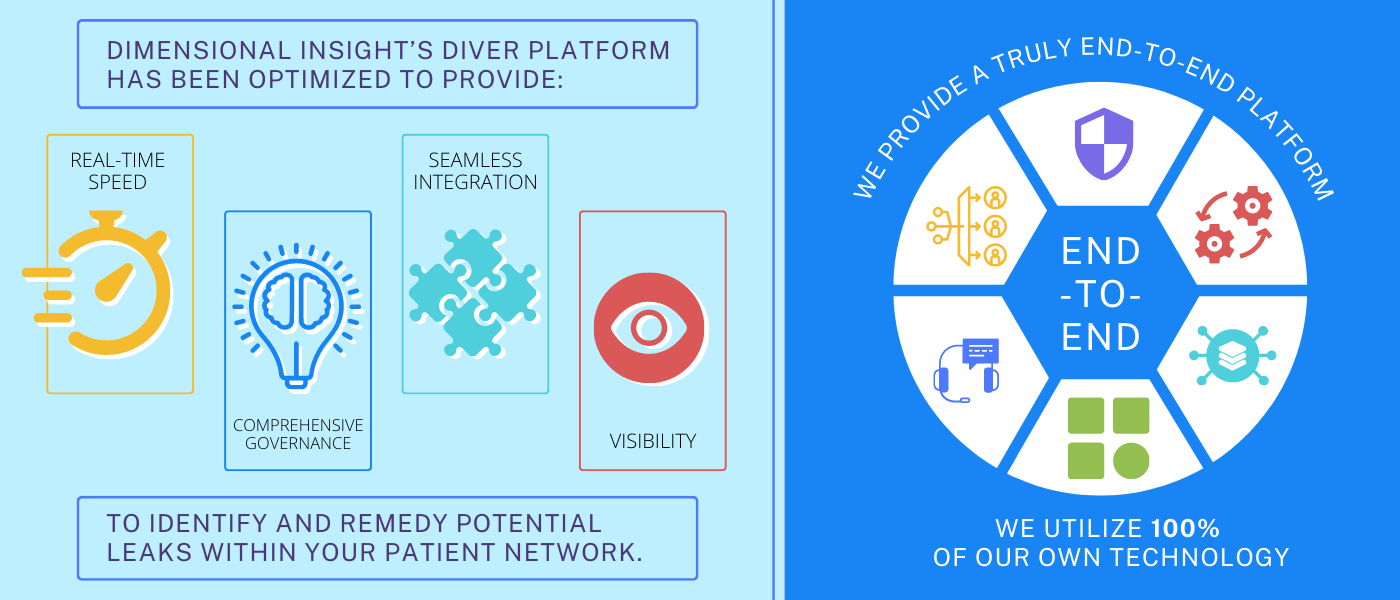Patient leakage, or when patients obtain healthcare services outside a hospital‘s network, has become a major burden for healthcare organizations everywhere. On top of costing hospitals potentially millions in lost revenue, patient leakage can also lead to delays in patient diagnosis or care, diminished visibility into the patient’s healthcare journey, and reduced care continuity. According to ABOUT’s Patient Leakage & Keepage Report for 2021-22, nearly all (94%) hospital executives reported that reducing patient leakage is a top priority in 2022.
The same report also found that unfortunately, 90% of executives aren’t confident in their visibility into how many patients are actually seeking care from outside from their system, and 91% aren’t sure they’re actually able to calculate what it’s costing them. Healthcare organizations know that leakage is hurting them, but they don’t know just how much, or what they can do about it.
The solution? Data analytics.

Reveal current leaks and hotspots
One effective means for discovering where your organization is losing revenue from lost referrals is by evaluating current data in relation to prior performance. Understanding the relationship between the past and present can reveal changes in patient referral patterns and whether or not current strategies need to be adjusted to regain previous patient intake volumes.
A drop in referrals from a specific provider may indicate a problem with either your services or that office. The next step is to determine what this problem may be, whether it be an issue with new staffing, miscommunication between offices, or some other newly introduced factor.
However, discovering the underlying causes behind these obstacles requires an analytics platform that can help expose both challenges and opportunities capable of diving into details of the data. Advanced tools, such as Dimensional Insight’s Diver Platform, allow organizations to gain a more nuanced perspective of what’s driving changes within their patient-referral program.
Analyze your network
One effective approach to implementing new strategies and address potential weaknesses is to identify what exactly is working in your network, and what isn’t. For some systems, a particular specialist may attract a significant number of referrals due to their reputation or niche. For others, a high volume of inbound referrals could be the result of strong existing relationships with other healthcare institutions or specific providers.
Regardless of what’s bringing in your referrals, your data can reveal why it works and what you can do to capitalize on its success. Additionally, having a particularly strong source for referrals means little in the grand scheme if you’re unable to learn from it and apply it to other potential channels.
But again, most of this knowledge often goes untapped due to administrative oversight and a lack of support for data-driven decision-making. Many organizations don’t possess the network visibility necessary to identify meaningful and actionable insights. This is where data analytics platforms with flexible and nuanced reporting are crucial.
Establish predictive models
The best defense is a good offense. By looking to the future and addressing potential leaks before they happen, hospitals can proactively curve a significant portion of their revenue lost due to out-of-network referrals.
With predictive analytics, providers can utilize artificial intelligence techniques to identify patients who are likely to travel out-of-network for their treatment. For example, hospitals can review patterns of utilization for specialist consultations outside their network to formulate a plan with their own specialists for better patient engagement and retention.
Likewise, demographic information regarding your patient population can reveal potential weaknesses within your provider network. A large volume of patients with young children might necessitate an increase in pediatric services, while a retirement community might require more attention paid to geriatric care.
Predictive patient analytics can help hospitals adapt their care management strategies based on factors like distance from healthcare facilities. A one-size-fits-all approach rarely works in healthcare, and it’s critical that healthcare systems pare able to meet the needs of their patients in a practical manner if they’re to keep patients within their own network.

Set expectations
Comparing their data against industry benchmarks is one of the easiest ways for healthcare systems to evaluate how their in-network referral programs are currently performing. Information related to certain dimensions, such as location or services offered, allows executives to evaluate how they fare against similar organizations and what measures need to be put in place to improve their competitive value.
Furthermore, this information can be used to highlight productivity weak points within their own organizations. By setting expectations for measures like referral response rates or turnaround time based off industry standards can help administrators determine if current leakages may be related to inefficient processing on their end.
Choosing the right platform
Adding to these challenges, understanding patient leakage requires access to multiple sources of data that often have different formats and follow different conventions. Many healthcare IT systems lack the flexibility to integrate and standardize data at this scale. Turning your raw data into actionable insights requires a powerful platform that can provide consolidation, standardization, analysis, and visualization all in one package.
Dimensional Insight’s Diver Platform has been optimized to provide unparalleled speed, integration, flexibility, and governance. The platform provides an integrated set of analytical services that work together seamlessly to help you assemble and analyze the most relevant information. Other approaches that rely on multiple technologies lack the flexibility to meet the nuanced challenges of the healthcare industry. With Dimensional Insight, you gain real-time speed, seamless integration of data sources, the flexibility to view data the way you want to see it, and the governance that provides a single source of truth for your organization.
Finally, Dimensional Insight knows healthcare. Our staff have spent decades solving customers’ most daunting analytical problems and fine-tuning the Diver Platform to deal with the unique challenges of healthcare information in the process.

Learn more
Interested in learning more about how data analytics can help your hospital address challenges in the healthcare industry? Check out this white paper—“How to Accelerate EHR Insights with an Enterprise Analytics Platform.”
- How Spirits Brands Can Improve Brand Loyalty with Data Analytics - January 30, 2024
- The Collapse of Herbl, and How Other Cannabis Distributors Can Avoid the Same Fate - January 24, 2024
- Top 5 Blog Posts of 2023 - December 28, 2023



